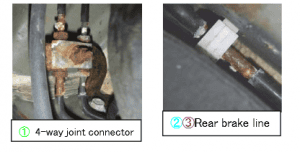Subarus Recalled for Brake Line Corrosion
Last summer, Subaru issued a recall for 660,000 vehicles because of the potential for brake line corrosion. The affected vehicles are:
- The Forester, from 2009 to 2013
- The Impreza, from 2008 to 2011
- The Impresa WRX and WRX STI, from 2008 to 2014
- The Legacy and Outback wagons, from 2005 to 2009
Last June, Subaru’s parent company, Fuji Heavy Industries, sent an updated letter to the Recall Management Division of the National Highway Traffic Safety Administration (NHTSA). The letter informed the NHTSA that Subaru was recalling the affected vehicles in salt belt states because of brake lines with insufficient splash protection. Subaru concluded after testing that driving in salty meltwater and slush could cause the center and rear brake lines to rust through. (Their word was “perforate.”) Brake fluid could then leak out and affect the vehicles’ braking power. You can read the entire letter here. The New York Times ran a story on the recall on June 27, and they explained the problem this way:
Subaru told federal regulators in its report that examination of returned parts showed that some brake lines could rust through after several winters because a gap in the shielding around the fuel tank could allow salt water to reach them. A hole in the line would allow brake fluid to escape. The automaker said that if that happened, a warning light would illuminate. The vehicle would not lose all its braking power, the automaker said, but the driver “might misjudge the amount of brake pedal travel required to achieve the desired stopping distance.”
Not all braking power would be lost because these cars have two separate brake line systems. So both of them would have to develop holes before the brakes could fail entirely, and the chances of their rusting through simultaneously is very small. Of course, if your brake light comes on and you ignore it because you can still stop, then you could be in trouble. Fuji’s solution to the problem is interesting:
The remedy plan calls for dealers to inspect and determine if brake fluid seepage is present around the affected areas indicated in the previous diagrams. This is accomplished by depressing the brake pedal firmly during engine idle.• Scenario No. 1: If no brake fluid seepage is observed, the affected areas will be rustproofed with anti-corrosion wax.• Scenario No. 2: If brake fluid seepage is observed, the original center and rear brake lines will be replaced withnew ones followed by rustproofing with anti-corrosion wax.

 Buy US Direct
Buy US Direct Buy CA Direct
Buy CA Direct Buy EU Direct
Buy EU Direct Buy DE Direct
Buy DE Direct